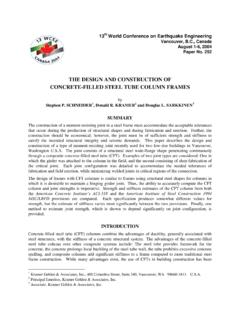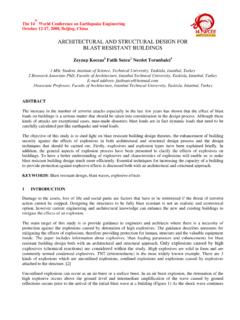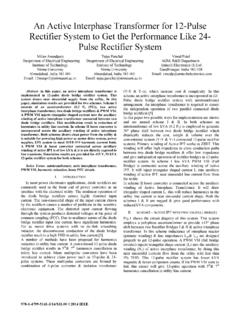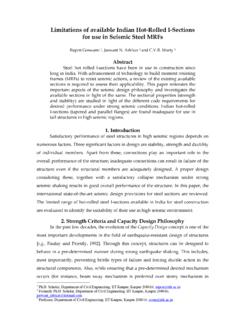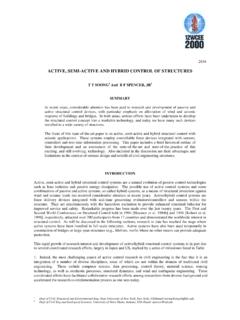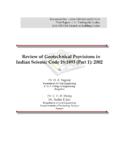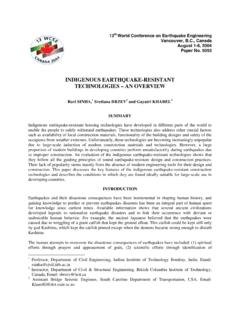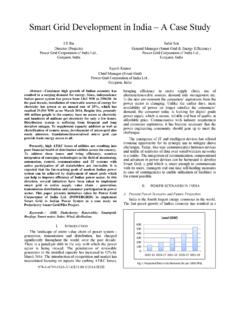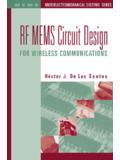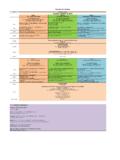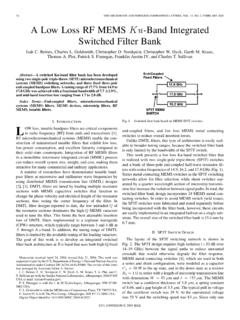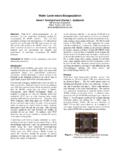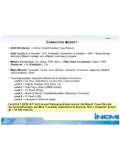Transcription of Smart Sensing Technology for Structural Health …
1 13th World Conference on Earthquake Engineering Vancouver, , Canada August 1-6, 2004 Paper No. 1791 Smart Sensing Technology FOR Structural Health monitoring Billie F. SPENCER , Manuel RUIZ-SANDOVAL2, Narito KURATA3 SUMMARY Smart sensors with embedded microprocessors and wireless communication links have the potential to fundamentally change the way civil infrastructure systems are monitored, controlled, and maintained. Indeed, a 2002 National Research Council Report [1] noted that the use of networked systems of embedded computers and sensors throughout society could well dwarf all previous milestones in the information revolution.
2 However, a framework does not yet exist that can allow the distributed computing paradigm offered by Smart sensors to be employed for Structural Health monitoring and control systems; current algorithms assume that all data is centrally collected and processed. Such an approach does not scale to systems with densely instrumented arrays of sensors that will be required for the next generation of Structural Health monitoring and control systems. This paper provides a brief introduction to Smart Sensing Technology and identifies some of the opportunities and associated challenges. INTRODUCTION The design, fabrication, and construction of Smart structures are one of the ultimate challenges to engineering researchers today.
3 Because they form the essence of system intelligence, one of the cores of Smart structures Technology centers around innovative sensors and sensor systems. Structural Health monitoring (SHM) represents one of the primary applications for new sensor technologies. Indeed, much attention has been focused in recent years on the declining state of the aging infrastructure in the , as well as to the limitation of their responses during extreme events (such as wind and earthquakes). These concerns apply not only to civil engineering structures, such as the nation s bridges, highways, and buildings, but also to other types of structures, such as the aging fleet of aircraft currently in use by domestic and foreign airlines.
4 1 Nathan M. and Anne M. Newmark Endowed Chair in Civil Engineering and NCSA Senior Center Affiliate, University of Illinois at Urbana-Champaign, Urbana, IL 61801, USA 2 University of Notre Dame, Notre Dame, IN, 46556, USA (On leave from Universidad Autonoma Metropolitana) 3 Kajima Corporation, KI Building, 6-5-30, Akasaka, Minato-ku, Tokyo, Japan, 107-8502, Japan, The ability to continuously monitor the integrity of structures in real-time can provide for increased safety to the public, particularly for the aging structures in widespread use today. The ability to detect damage at an early stage can reduce the costs and down-time associated with repair of critical damage.
5 Observing and/or predicting the onset of dangerous Structural behavior, such as flutter in bridges, can allow for advance warning of such comportment and commencement of removal of the structure from service for the protection of human life. In addition to monitoring long term degradation, assessment of Structural integrity after catastrophic events, such as earthquakes, hurricanes, tornados, or fires, is vital. These assessments can be a significant expense (both in time and money), as was seen after the 1994 Northridge earthquake with the numerous buildings that needed to have their moment-resisting connections inspected. Additionally, structures internally, but not obviously, damaged in an earthquake may be in great danger of collapse during aftershocks; Structural integrity assessment can help to identify such structures to enable evacuation of building occupants and contents prior to aftershocks.
6 Furthermore, after natural disasters, it is imperative that emergency facilities and evacuation routes, including bridges and highways, be assessed for safety. The need for effective SHM is clear, with the primary goals of such systems being to enhance safety and reliability and to reduce maintenance and inspection costs. To efficaciously investigate both local and global damage, a dense array of sensors is envisioned for large civil engineering structures. Such a dense array must be designed to be scalable, which means that the system performance does not degrade substantially or at all as the number of components increases.
7 In the conventional approach using wired sensors (see Fig. 1), the shear number of accompanying wires, fiber optic cables, or other physical transmission medium may be prohibitive, particularly for structures such as long-span bridges or tall buildings. Consequently, global communication in a wireless fashion that will facilitate low-cost, densely distributed Sensing has been investigated. Rapid advances in sensors, wireless communication, Micro Electro Mechanical Systems (MEMS), and information technologies have the potential to significantly impact SHM. To assist in dealing with the large amount of data that is generated by a monitoring system, on-board processing at the sensor allows a portion of the computation to be done locally on the sensor s embedded microprocessor.
8 Such an approach provides for an adaptable, Smart sensor, with self-diagnosis and self-calibration capabilities, thus reducing that amount of information that needs to be transmitted over the network. Kiremidjian [2] pointed out that pushing data acquisition and computation forward is fundamental to Smart Sensing and monitoring systems such as are illustrated in Fig. 2, but represents a radical departure from the conventional instrumentation design and computational strategies for monitoring civil structures. Following an introduction to Smart Sensing , some of the opportunities, as well as the challenges offered by this new Technology , are presented. Figure 1.
9 Traditional SHM System using Centralized Data Acquisition. Figure 2. SHM System with Smart Sensors. WHAT ARE Smart SENSORS? To better understand what is meant by a Smart sensor, first consider the definition of a standard sensor. In general, a sensor is a device that is designed to acquire information from an object and transform it into an electrical signal. As shown in Fig. 3, a traditional integrated sensor can be divided into three parts: (i) the Sensing element ( , resistors, capacitor, transistor, piezo-electric materials, photodiode, etc.), (ii) signal conditioning and preprocessing ( , amplifications, linearization, compensation, and filtering), and (iii) a sensor interface ( , the wires, plugs and sockets to communicate with other electronic components) (Kirianaki [3]).
10 As illustrated in Fig. 4, the essential difference between a Smart sensor and a standard integrated sensor is its intelligence capabilities, , the on-board microprocessor. The microprocessor is typically used for digital processing, analog to digital or frequency to code conversions, calculations, and interfacing functions, which can facilitate self-diagnostics, self-identification, or self-adaptation (decision making) functions (Kirianaki [2]). It can also decide when to dump/store data, and control when and for how long it will be fully awake so as to minimize power consumption. The size of Smart sensors has been decreasing with time.
